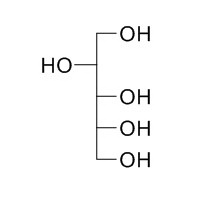D-arabinitol
D-arabinitol is a marker for the diagnosis of disseminated candidiasis and for monitoring response to antifungal therapy.
Inquire / Order:
manager@chemfaces.com
Technical Inquiries:
service@chemfaces.com
Tel:
+86-27-84237783
Fax:
+86-27-84254680
Address:
1 Building, No. 83, CheCheng Rd., Wuhan Economic and Technological Development Zone, Wuhan, Hubei 430056, PRC
Providing storage is as stated on the product vial and the vial is kept tightly sealed, the product can be stored for up to
24 months(2-8C).
Wherever possible, you should prepare and use solutions on the same day. However, if you need to make up stock solutions in advance, we recommend that you store the solution as aliquots in tightly sealed vials at -20C. Generally, these will be useable for up to two weeks. Before use, and prior to opening the vial we recommend that you allow your product to equilibrate to room temperature for at least 1 hour.
Need more advice on solubility, usage and handling? Please email to: service@chemfaces.com
The packaging of the product may have turned upside down during transportation, resulting in the natural compounds adhering to the neck or cap of the vial. take the vial out of its packaging and gently shake to let the compounds fall to the bottom of the vial. for liquid products, centrifuge at 200-500 RPM to gather the liquid at the bottom of the vial. try to avoid loss or contamination during handling.
Korean J Environ Agric.2018, 37(4):260-267
Plants (Basel).2021, 10(6):1192.
Processes2021, 9(11),2065.
Brain Res Bull.2024, 218:111103.
Chem Biol Interact.2023, 378:110487.
Foods.2023, 12(12):2412.
Appl. Sci.2020, 10(4),1304
Chinese Pharmaceutical Journal2023, 58(2):178-187.
CZECH MYCOLOGY2021, 73(1):1-19.
Molecules.2023, 28(2):727.
Related and Featured Products
J Med Vet Mycol. 1994;32(3):205-15.
Serum D-arabinitol measured by automated quantitative enzymatic assay for detection and therapeutic monitoring of experimental disseminated candidiasis: correlation with tissue concentrations of Candida albicans.[Pubmed:
7965491]
In order to further understand serum D-arabinitol (DA) as a marker for the diagnosis of disseminated candidiasis and for monitoring response to antifungal therapy, we studied the serum levels of this Candida carbohydrate metabolite by rapid automated enzymatic assay in rabbits with experimental disseminated candidiasis. As a correction for renal impairment, data were expressed as serum D-arabinitol/creatinine ratio (D-arabinitol/Cr). Serum creatinine concentrations were determined from the same sample with the same instrument, thereby allowing rapid determination of the D-arabinitol/Cr within one laboratory.
METHODS AND RESULTS:
The D-arabinitol/Cr was determined in 321 samples from 132 rabbits. The mean serum D-arabinitol/Cr in 31 normal non-infected rabbits was 1.51 +/- 0.2 microM mg-1 dl-1. Among 84 rabbits with disseminated candidiasis and pre-terminal samples, there was a direct correlation between D-arabinitol/Cr and tissue concentration of Candida albicans (r = 0.80; P < 0.001). A threshold of elevated D-arabinitol/Cr (> or = 3.0 microM mg-1 dl-1) was evident in rabbits with a tissue concentration of C. albicans > or = 3 x 10(4) colony forming units (CFU) g-1. Elevated D-arabinitol/Cr was detected in 48 (89%) of 54 rabbits at a C. albicans tissue concentration of > or = 3 x 10(4) CFU g-1 vs. The relationship between the tissue response to antifungal therapy and change in D-arabinitol/Cr was then further analysed. Ten (91%) of 11 rabbits with a tissue-proven response to antifungal therapy (defined as > or = 10(2)-fold reduction of CFU g-1 in comparison to untreated controls) had a > 50% reduction in elevated D-arabinitol/Cr levels. By comparison, 10 (83%) of 12 treated rabbits with no response to therapy had persistently elevated D-arabinitol/Cr levels (P < 0.001).
CONCLUSIONS:
These findings provide an experimental basis for understanding the patterns of expression of serum D-arabinitol in disseminated candidiasis and further indicate that serial D-arabinitol/Cr measurements may be useful for diagnosis and therapeutic monitoring of disseminated candidiasis.
J Bacteriol. 2012 Apr;194(8):1868-74.
Biochemical characterization of the CDP-D-arabinitol biosynthetic pathway in Streptococcus pneumoniae 17F.[Pubmed:
22328666 ]
The biosynthetic pathway of D-arabinitol, which is present in the CPSs of several S. pneumoniae serotypes, has never been identified.
METHODS AND RESULTS:
In this study, the genes abpA (previously known as abp1) and abpB (previously known as abp2), which have previously been reported to be responsible for nucleoside diphosphate (NDP)-D-arabinitol (the nucleotide-activated form of D-arabinitol) synthesis, were cloned. As a result, abpA was identified to be a D-xylulose-5-phosphate cytidylyltransferase-encoding gene, responsible for the transfer of CTP to D-xylulose-5-phosphate (D-Xlu-5-P) to form CDP-D-xylulose, and abpB was characterized to be a CDP-D-xylulose reductase-encoding gene, responsible for the conversion of CDP-D-xylulose to CDP-D-arabinitol as the final product. The kinetic parameters of AbpA for the substrates D-Xlu-5-P and CTP and those of AbpB for the substrate CDP-D-xylulose and the cofactors NADH or NADPH were measured, and the effects of temperature, pH, and cations on the two enzymes were analyzed.
CONCLUSIONS:
This study confirmed the involvement of the genes abpA and abpB and their products in the biosynthetic pathway of CDP-D-arabinitol.



